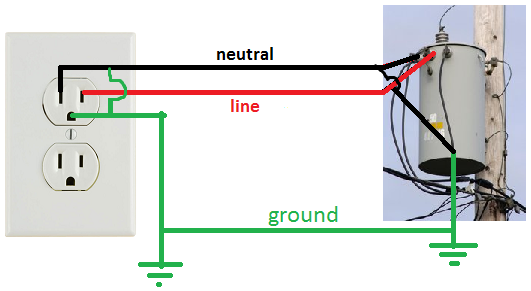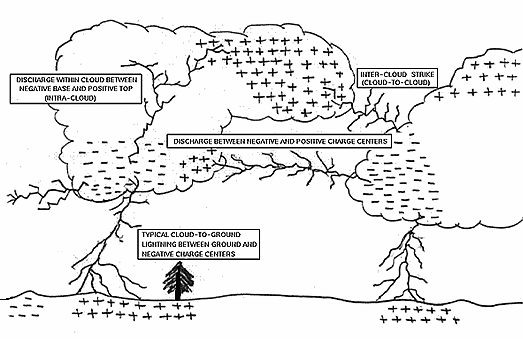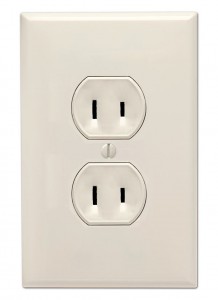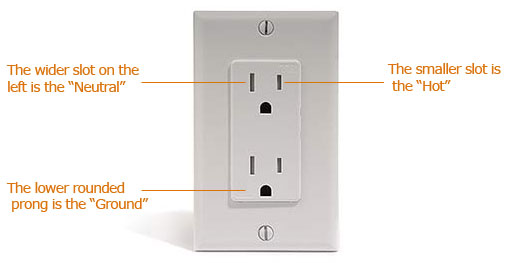Three Prong Circuits
Three Prong Plugs
The Main Idea
Why do outlets need that third prong? Grounded electricity explained without any confusing math or equations.
A Mathematical Model
Don't be silly, this is a page for dummies. Let's not bother with equations, as the real world is more complex than theory as it is.
A Computational Model
Below is a circuit diagram of the standard American three-prong outlet. The third prong provides a common zero voltage at either side of the black neutral connection, and removes the possibly fatal consequences of the neutral line resistance from the electric circuit.

Groundedness
Sparks
Theoretically, in an AC system where there is no "plus" and "minus" an electric plug's two wires should be interchangeable. But let's get real, reality is much more complicated than theory and issues will "spark" up regardless of how perfect the circumstances are.
So let's build a theoretical situation where you, a highly accomplished engineer and businessman, want to create your own electric power distribution system for surrounding customers.
Now, customers are calling and complaining that their fridges and stoves are failing. You receive a lawsuit stating that one of your customers had a powerful electric shock strike them unconscious. How come DC voltage are appearing in what is supposed to be an alternating current system?
Explosions
Every thunderstorm, you experience a disturbing trend where every customer's appliances are getting blown to pieces, as huge arcs of electricity streak across to strike your customers dead. Apparently, when lightening strikes your distribution center, a lightening-impulse voltage runs through the entire system and to your customers' homes. Many lawsuits follow.
But you still don't give up. So you do some research.
You find out a game-changing fact: that the earth acts as a electrostatic generator.

As thunderstorms push negative charges into the earth, and the earth filters the charges upward, a vertical charge flows through the earth-atmosphere system. A DC charge can build up and depending on wire heights and thunderstorm locations, this charge can be huge, ranging from hundreds to thousands of volts. You realize your electric distribution center performs as an antenna for the earth to the sky and creates a large potential difference.
Solution (or so you think)
You need to halt these customer accidents. After trial and error, you realize you must connect your electric system to the earth to drive away the lightening and excess charges away from your business and your customers. Plunge long metal rods deep into the earth, link your wires to these poles and allow the unnecessary electricity to be carried far away from you.
Obviously, you know enough to understand you can't attach both wires of your system to these rods, as this would short it out. So, pick your favorite wire and connect just that one, at many intercepts along your power lines. You explain to the electricians you hired that, if there happen to be any contingencies and the lines are disconnected, static discharge does not present itself to be a hazard to your customers, nor you. Now, regardless of the weather, any currents can be rerouted away from your paying customers and into the ground.
Murphy's Law
"Murphy's Law is an adage or epigram that is typically stated as: Anything that can go wrong, will go wrong." (-Wikipedia, Murphy's Law)
According to Murphy's Law, since you've solved one problem, another one or two emerge.
Customer Death Toll Rises
You grounded your electric system and unknowingly, more of your customers begin to die. You're starting to really lose any chance for profit as you hire more and more lawyers to protect you against corporate negligence. But what is going on? You can feel you have almost created a complete solution to your electrical system.
Turns out, your customers are ignorant of the physics of electricity! How dumb of them! So one of your wires is connected into the ground and completely safe, but the other wire has suddenly become a death trap for any of your foolish customers. When they come into contact with any of those exposed second wires, usually the customer is standing on the ground. The same ground that you used to ground your electric system, is the same ground that has connected your network to your customers' feet. Now usually, the floor is a poor conductor, but often times the floor will be damp or covered in a stronger conductor. Your unaware and sleepy customers stumble barefoot into the garage to power off the Christmas lights, and as they fumble around the cables, their finger brushes against an exposed non-neutral wire. He closes an undesired and painful AC current that rushes through his salty, conducting blood, and into his heart muscle, causing it to fibrillate. He was found clutching his chest, barely breathing.
You are considering sending letters to all of your customers, requiring them to always wear footwear, keep their floors dry, never shower or bathe, and stay away from appliances as a precaution.
Curious Face Outlet
Here we enter the age the of the "Curious Face Outlet". You have pressured all electricians and electric manufacturers that during installation, they are to preserve the wiring polarity. The long slot is the neutral side of any appliance's metal casing, and the short slot is for the "hot" side.

But electric issues continue to persist.
The Third Prong
You came up with the genius idea to add a third prong! So you link it to the neutral side, and connect a brand-new third wire to the outlets. Perfect Electricians are very hard (and expensive) to come by, so to ensure--or at least try to-- that they don't mix up the wires, you assign the third wire a different color, as well as distinguishable new shape.
And voila! The Third Prong works, and we enter the age of the "Curious Traumatized Face Outlet".

Fuses begin blowing to alert customers of faulty appliances, and when a worker accidentally drops a power drill into a wet puddle, the current is redirected to the appliance's casing rather than the worker's expensive body.
Congratulations, you have exponentially saved lives and harm for generations to come.
Connectedness
How is this topic connected to something that you are interested in?
The grand perspective of the earth and our dependency on the systems we create is fascinating. No matter what genius and "ground-breaking" (get it, GROUND-breaking?) concept humankind creates and actually produces, nature is always bigger and more powerful than us. Physics and philosophy can definitely mix and inspire our technology.
How is it connected to your major?
Being an industrial engineer, electric circuits can become part of an equation we may need to be aware of when establishing optimal industrial systems within neighborhood wirings, stoplight posts, etc. In the future, as a lawyer, it is important to differentiate between customer and manufacturer negligence, as well as simply unforeseen natural phenomenons.
Is there an interesting industrial application?
There is an enormous industrial application regarding electric circuits. As shown in the hypothetical electric system business, circuits are a foundation for any industrial, commercial, or home function.
History
Electric circuits have been the greatest trial-and-error concept that mankind has been able to establish to fuel every day-to-day functions. The first electric circuit was invented by Alessandro Volta in 1800, and the first grounded outlet was installed in 1959. There was a lot of construction in between these times, a lot of electrocution and many fatal electric shocks. Many people suffered because of imperfect wiring and casings. But now, although there are still errors in human construction, we can be assured that we are as safe as we ever have been in the history of electricity.
References
This article could not have been made possible without the genius description written by William Beaty in 1996. Retrieved from http://amasci.com/amateur/whygnd.html. Also, the following resources were very helpful in this article's development:
Photo Credits: